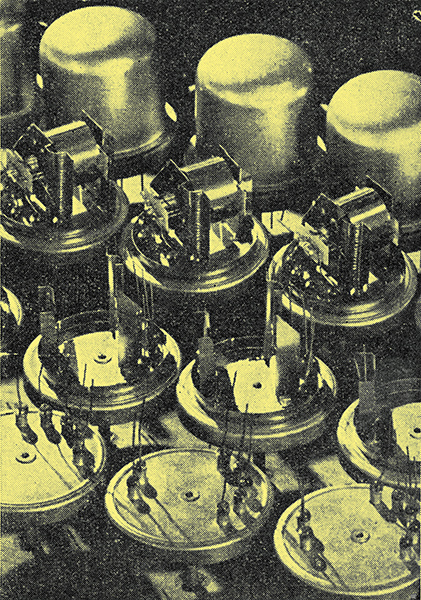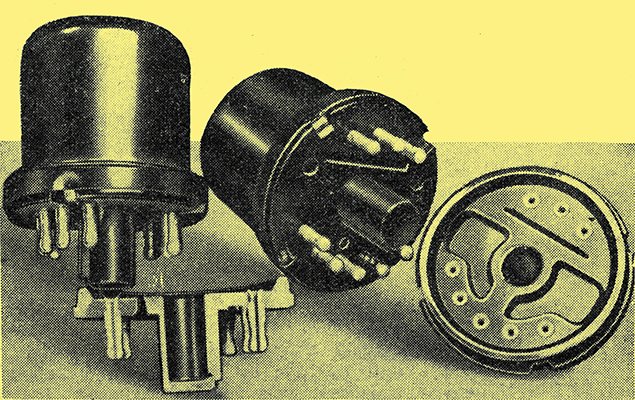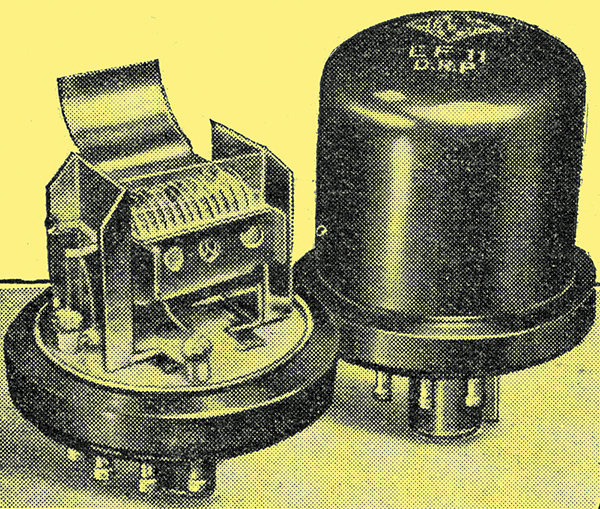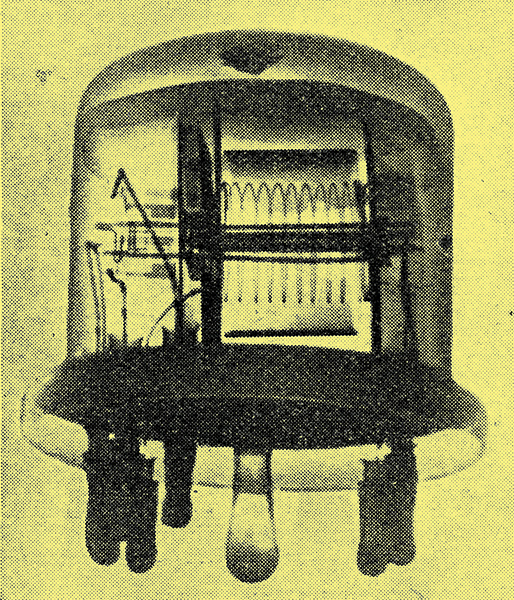|
New German productions compared with glass and earlier metal types

The author suggests that the robustness of the earlier type of all-metal valve is more apparent than real; he goes on to describe the horizontal electrode assembly of the new German Telefunken steel valves, which, it is claimed, provides greater rigidity, lower inter-electrode capacity and higher mutual conductance.
Just before the recent Berlin Show Telefunken brought out a new series of valves which aroused considerable interest. The group embraces 13 types characterised by the letter 'E', and is called the 'harmonic series'. This name, which rather puzzled foreign visitors, was chosen because the different units of the series are adapted to work together in such a way as to provide optimum performance with a minimum of tubes. The heater voltage is fixed at 6.3 Volts. The RF and IF tubes can, therefore, be run in parallel from AC mains, or from the storage battery of a motor car, or in series from DC mains. This is a step towards standardisation and reduction of types as the special DC and car-radio types have now become unnecessary. Heater current for these tubes is uniformly fixed at 200 mA, which is a considerable reduction as compared to previous Telefunken valves.

The German (Footless) base is similar to the American Octal, but the pins are differently arranged. Note the slot into which a screening plate can be inserted.
The most interesting feature of the new tubes, however, is their inner structure, which departs from conventional standards in several respects. With the exception of the output and rectifier valves, for which the glass bulb is preferable, and of the tuning indicator tube where it is indispensable, the valves of the E series have a steel envelope. It would be wrong, however, to assume that the new Telefunken productions are imitations of the 'metal tubes' which were put on the market some years ago in the USA. The use of metal for the outer envelope of transmitting and receiving tubes is an old idea which did not - to the knowledge of the writer - originate in America. The problem of providing an effective seal between glass and metal was solved in the USA by separate insulation of the lead wires with individual glass beads sealing Fernico eyelets one for each wire. While this was a very important contribution it was unfortunate that advantage was not taken of the opportunity to do away with other fundamental disadvantages of the old glass tube, which are far more important than the use of glass for the envelope, and which are caused by the conventional system of fixing the inner parts or electrodes by means of a comparatively narrow glass tube pinched at the top to hold the wires and produce a vacuum-proof seal.
As everyone experienced in the handling of valves knows, it is not the glass bulb which generally suffers from the effects of shock and vibration, but the inner metal structure. This is partly due to the modern tendency towards reduced inter-electrode spacing and the considerable length of the electrode supports. The claim that metal tubes are inherently more rugged than glass tubes is justified only in so far that a certain improvement in the method of fixing the electrodes had actually taken place. No material change had, however, been effected in the design of the electrodes themselves, Which retained the shape and disposition usual with glass tubes and were, therefore, liable to the same sort of mishaps.
Where, then, are the advantages of the metal envelope to be found if its obvious immunity from breakage is ignored? In the first place, steel has the advantage over glass that it not only constitutes an enclosure for the vacuum but also a screen against electromagnetic and electrostatic fields. It therefore serves a dual purpose, while the glass tube necessitates separate screening which may either consist of a separate shield or of a metal coating connected to one of the socket prongs. As output and rectifier valves need no screening, there is no point in giving them a metal envelope. On the contrary: as these tubes give off considerable heat a metal casing would actually be undesirable. That is one of the reasons why, for these special purposes, the metal tube has not made much headway in America, and glass tubes are preferred. The new Telefunken E series, for the same reason, consists of steel and glass tubes, according to the purpose of each type.
Short Lead-in Wires
The second. advantage of the steel valve which could, however, also be arrived at by new methods of glass design consists in the novel method of arranging and sealing the lead wires. With the old glass tube, these wires run closely parallel for a considerable distance in the lead-in tube, then converge to form the pinch and separate again to reach the various points of connection inside the tube. The wire lengths are considerable, as the pinch is quite a distance from the valve base, and, furthermore, the electrodes project well above the pinch. The grid lead is introduced at the top of the whole system, necessitating lengths of external screened lead to connect with the corresponding point of the circuit. The entire system is by no means completely rigid and so is affected by vibration and shocks; it is also characterised by considerable inter-electrode capacities.
Some of these disadvantages were reduced in the American metal valve by the elimination of the pinch and shorter connections between electrodes and tube base. The main drawback however - the length and non-rigidity of the active system, remained materially as it was in the glass tube.
Horizontal Electrode Assembly

RF pentode, Type EF11, with anode opened out to show inner electrodes. The channel-section support on the left acts as a screen for the leading-out wires.
The fundamental innovation in the new Telefunken steel tube consists in the horizontal disposition of the entire active system on a strong steel base plate, allowing rigid mounting at both ends by means of short U-section metal struts welded to the base plate. As both ends of the electrodes are now equally close to the base, and as the lead wires run straight down from their connecting points to the base prongs, all lead wires have been reduced to a fraction of their former length and are, moreover, spaced well apart. The long and sometimes wobbly structure characteristic of the present-day valve, often necessitating the addition of resilient mica spacers for support in the upper part of the glass or metal tube envelope, has completely disappeared. The extreme rigidity of the new structure is immediately apparent. The importance of this feature consists not only in the reduction of break-downs and of vibration effects , such as microphonic noises, howling, etc., but also in the possibility of bringing the different electrodes yet nearer together, thereby improving the electrical performance of the tube, without risking an increase in the percentage of rejects or defects. The sealing of the lead wires in the base plate is effected in the usual manner by glass beads in Fernico eyelets and the steel envelope is welded to the base plate, as are the electrode supports. As a consequence of the horizontal arrangement of the inner structure the tubes are shorter than the American metal valves, the diameter being slightly greater
Another advantage of the new arrangement, due to the reduced length of, and great distance between, the lead wires, has resulted in exceptionally low inter-electrode capacities. These allow of a very marked improvement in short-wave performance as compared with previous types of ordinary broadcast receiving tubes. Yet another new departure is the abolition of the grid cap on the dome of the tube and the disposition of the grid connection alongside the others on the tube base. This not only does away with an important source of breakdown, the precariously located grid cap being one of the worst causes of trouble, but it gives the designer far greater freedom for the layout of his wiring and the arrangement of his coil assemblies, while reducing the length of the critical grid connections. Provisions are made on valve base and socket for the insertion of a little screen plate separating the leads which require screening from the others. The base is similar to the American octal base; however, there are three prongs in one group and five in the other, separated by the slot for the screen plate, which has the additional advantage of increasing the insulation resistance be tween the two groups of prongs. The base is so designed as not to lower the performance of the active parts in any direction whatsoever. The glass tubes of the series are also equipped with the new base. It is not without interest to observe the great difference between the methods of launching a new type of valve in America and Germany. In the USA metal valves were introduced rather precipitously as a combative measure in the fight for market supremacy between great private business concerns. Engineers were hardly ready for mass production on a really big scale and alarming percentages of rejects were at first experienced, putting the entire idea in jeopardy. On the other side publicity was loud and assertive. Glass tubes were described as obsolete and metal tubes - in spite of the similarity of their electrode assembly - as immeasurably superior. The public was induced to demand metal tubes because sets would be improved by using them in preference to glass tubes. Disillusion followed very soon and metal valves suffered a setback which led to a relative advance of the glass tube. All this had very little to do with the actual technical merits of the case.
In Germany the valve and set makers got together and decided to bring out no new tubes for an entire year, devoting the time to laboratory development and manufacturing experiments. The result consisted in ripe new designs which were agreed by all concerned to ensure an improvement of sets and a reduction of costs for both the interested parties. The new tubes were first introduced on a small scale for car radio use, and valuable experience gained in manufacturing them. The industry then decided to introduce the steel tubes in this year's receivers, but limited their use to the higher price classes. The cheaper mass-production sets retain the old glass tubes. Production of the new tubes was therefore increased gradually, not by leaps and bounds, and difficulties could be completely avoided. Ballyhoo was strictly vetoed and the public was not told that old tubes were now obsolete and should be replaced by new ones. On the contrary, it was pointed out that the new valves would not be of any immediate interest to the listening public, but that they would enable designers in future to build better sets for the same price. Sensationalism was thus replaced by conscientiousness, precipitation by thoroughness and commercial egotism by purposeful industrial co-operation. This method should prove more economical, safer and better in the long run and it will certainly tend to increase the confidence and good will of the public towards the industry.

X-ray photograph of Type ECH11 frequency-changer. The triode oscillator section, on the left, is screened from the other electrodes by the left-hand support.The pumping tube is seen below the base plate, between the two groups of pins.
|